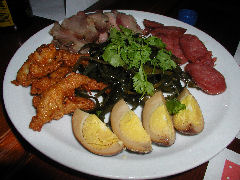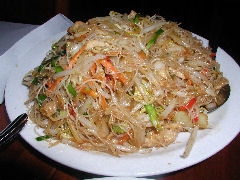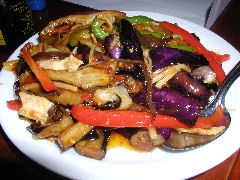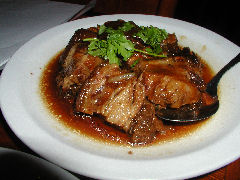Buenos Aires – Apparently, Monday is the Sunday of Chinatown here. Who knew that virtually every single restaurant in Barrio China is closed on the day of the moon? Met up with my friend Heather, planning on a lovely lunch at BuddhaBA it was closed, so was Siempre Verde, in fact, there were only 2 restaurants open on the entire strip that we saw. Even nearby Contigo Peru, for a casual Peruvian lunch, was shuttered for the day. Neither of the two open options looked overly exciting, but one of them at least had Chinese people eating in it, 3 or 4 of them anyway. Thankfully, Dragon Porteño Arribeños at Arribeños 2137, turned out to be a decent option.
 We did the usual “let’s order a few things to share” and found ourselves confronted by just a bit too much food. Nonetheless, we ate most of it, and enjoyed it all. This is the Entrada China Mixta Chica, or small mixed Chinese appetizers. On the plate, some sweet chinese sausages, roast pork, deep-fried fish, soy and tea marinated eggs, and pickled seaweed. Not quite what we were expecting, I think both of us envisioned a plate with a sampler of things like dumplings, springrolls, and other sorts of more usual suspects. But, this was quite good.
We did the usual “let’s order a few things to share” and found ourselves confronted by just a bit too much food. Nonetheless, we ate most of it, and enjoyed it all. This is the Entrada China Mixta Chica, or small mixed Chinese appetizers. On the plate, some sweet chinese sausages, roast pork, deep-fried fish, soy and tea marinated eggs, and pickled seaweed. Not quite what we were expecting, I think both of us envisioned a plate with a sampler of things like dumplings, springrolls, and other sorts of more usual suspects. But, this was quite good.
 A pretty standard dish to share followed up – Fideos Saltado con Pollo, a stir-fry of thin noodles with lots of vegetables and chicken. It definitely needed something to zip it up a bit, and a dish of chili oil was brought out quickly. The real fault to this dish, tasty as it was, was that it, and the two subsequent dishes, were just oily as could be. Thankfully the oil was fresh and not “well-used” or rancid, there was just too much of it. And despite any fault we may have seen in it, we completely finished off this plate, so I guess we liked it a fair amount!
A pretty standard dish to share followed up – Fideos Saltado con Pollo, a stir-fry of thin noodles with lots of vegetables and chicken. It definitely needed something to zip it up a bit, and a dish of chili oil was brought out quickly. The real fault to this dish, tasty as it was, was that it, and the two subsequent dishes, were just oily as could be. Thankfully the oil was fresh and not “well-used” or rancid, there was just too much of it. And despite any fault we may have seen in it, we completely finished off this plate, so I guess we liked it a fair amount!
 This had the potential to be the most interesting dish, both of the latter two dishes were ordered off the restaurant’s house specialties menu. According to that menu this was a picante dish, but it wasn’t even spicy by Argentine standards. There were a few scattered chili flakes in the dish, but basically it was sauteed eggplant with peppers and a few strips of pork tossed in. Now, Yu-Xiang style Eggplant is a Szechuan dish that should be spiced well with ginger, garlic, and hot bean paste. I think they just left the last ingredient out. Here’s what the recipe should be, taken from The Good Food of Szechwan by Robert Delfs.
This had the potential to be the most interesting dish, both of the latter two dishes were ordered off the restaurant’s house specialties menu. According to that menu this was a picante dish, but it wasn’t even spicy by Argentine standards. There were a few scattered chili flakes in the dish, but basically it was sauteed eggplant with peppers and a few strips of pork tossed in. Now, Yu-Xiang style Eggplant is a Szechuan dish that should be spiced well with ginger, garlic, and hot bean paste. I think they just left the last ingredient out. Here’s what the recipe should be, taken from The Good Food of Szechwan by Robert Delfs.
Eggplant with Yu-Xiang Sauce
4-8 Asian eggplants, about 1 lb.
¼ lb. pork tenderloin
2 scallions
1 handful finely chopped ginger
1 handful finely chopped garlic
1-2 T hot bean sauceSeasonings:
2 T soy sauce
1 t sugar
½ C chicken stock2 t sesame oil
1 T cornstarch mixed with 2 Tbsps. water
¾ C cooking oilCut the eggplant into 3-inch long strips as thick as your little finger, salt them and pat dry after 10 minutes. Meanwhile cut the pork into small pieces, at most ¼” on a side, chop the scallions into small pieces, and chop the garlic and ginger as finely as possible (a food processor works well). Mix the seasonings in a small bowl.
Heat 1/2 cup of the oil in a wok until very hot. Add the eggplant and turn the heat down to medium. Cook, stirring frequently, until the eggplant strips are soft and moist. Remove them from the wok with a slotted spoon and drain. Now heat 3 more Tbsps. of the oil in the wok until very hot. Add the pork, ginger, garlic and hot bean sauce. Cook until the red color of the bean sauce begins to be absorbed by the other ingredients. Add the Seasonings, stir briefly, and then add the precooked eggplant.
Cook, stirring occasionally, until the liquid begins to disappear. Add the scallions and sesame oil. Stir while adding the cornstarch and water mixture. When the sauce has thickened and begins to adhere to the eggplant strips, remove to a serving dish and serve immediately, with sticky rice and cold beer.
 The last dish is often one of my favorites in good Chinese restaurants. It’s essentially thick pork belly that’s been first boiled until very tender and soft, then cut into cubes, and then sauteed in a mixture of hot bean paste, soy, garlic, wine, and sugar. It’s usually called Double-Cooked Pork or something equally enlightening, here it was referred to as Pancetta con Verduras Secas or bacon with dried vegetables. There was indeed some sort of wrinkly something or other underneath the pork – it looked more like tofu skin than vegetable, perhaps it was something like cabbage, but I don’t think so. Flavorwise this was pretty good, and you’d expect it to be a bit greasy because of the pork belly, but this was also swimming in oil in addition.
The last dish is often one of my favorites in good Chinese restaurants. It’s essentially thick pork belly that’s been first boiled until very tender and soft, then cut into cubes, and then sauteed in a mixture of hot bean paste, soy, garlic, wine, and sugar. It’s usually called Double-Cooked Pork or something equally enlightening, here it was referred to as Pancetta con Verduras Secas or bacon with dried vegetables. There was indeed some sort of wrinkly something or other underneath the pork – it looked more like tofu skin than vegetable, perhaps it was something like cabbage, but I don’t think so. Flavorwise this was pretty good, and you’d expect it to be a bit greasy because of the pork belly, but this was also swimming in oil in addition.
Overall, I give this restaurant an okay. I like that they have some creative dishes not seen on most Chinese menus here. But I think their cook needs to learn to drain the oil off of things and to add a bit more spice.
[…] This dish was the winner of the lunch, at least from my view. Though listed as poco picante, it was anything but – quite spicy, and vinegary, and really excellent. It’s shredded pork “trilla yu xiang” style. Now, trilla in Spanish means something which is beaten or threshed, sort of like grain, and I’m guessing it’s just a mistranslation on the menu. Why should Chinese menus translated into Spanish be any better translated than into English? Yu Xiang style I discussed a couple of weeks ago – basically a spicy hot bean sauce with lots of ginger and garlic. The vinegar was a bit surprising, but then, I’m sure there are many local variations on all sorts of dishes. We also had a plate of beef mee fan, a bit short on the beef, and a bit oily and flavorless for me. […]
[…] One of my all time favorite vegetable dishes in Chinese cooking, a Szechuan dish, is Eggplant Yu-Xiang style. It’s spicy, it involves eggplant, which I love, and it’s kind of cool to pronounce. Unfortunately, Los Manjares couldn’t make it – quite simply it turns out, because there were no Asian eggplants, though long skinny ones, available in the markets. The manager explained that Yu-Xiang made with Italian style eggplants simply doesn’t work out right – the taste is wrong, the texture is wrong, and they simply won’t substitute. Something good to know – and might lead to a kitchen experiment here to explore the difference in the way they turn out… I accepted her recommendation for the spicy vegetable and pork stir-fry. It was good, but lacking in spice – I forgot to make it clear that I wanted it spicy by the standards of anyone who isn’t either Argentine or Italian… those little things one has to remember at times – we’d been having such a lovely chat that I guess I just assumed she’d picked up I wasn’t a porteño… perhaps she had, and just forgot to communicate it to the chef. Regardless, it was a nice mixture of peppers, onions, mushrooms, bamboo shoots, and Italian eggplant, lightly spiced, with shreds of pork. Decent in its own right, nothing special. […]
I’ve been back to this spot a few times since, and it’s definitely one of the more solid spots in Barrio Chino – I stand by my original thought that they need to spice things up a bit more and they do tend to use a bit much oil – but the first is easily remedied by telling your waitress that you’d like it spicy the way the Chinese would eat it – in fact, I just received a note from my friend Grant that he asked them for something more typically Chinese, and the waitress pointed to a list of items only in Chinese on the back of the menu and told him that those are what they eat – he picked one, I think at random, and had a great dish – so I’ll have to get back there and do the same!
[…] the main course, I thought a variation on Eggplant Yu-Xiang was in order, as the host wanted something with a good amount of ginger and spice. Instead of the […]
[…] Chinese classic, eggplant yu xiang – a spicy preparation with ground […]
[…] a specialty of the house, Eggplant Yu-Xiang, one of my favorites, with eggplant and small bits of pork sauteed in a spicy sauce, generally of […]
[…] version of eggplant yu xiang, typically a spicy and slightly sweet dish of braised eggplant and pork. This was lots and lots of […]